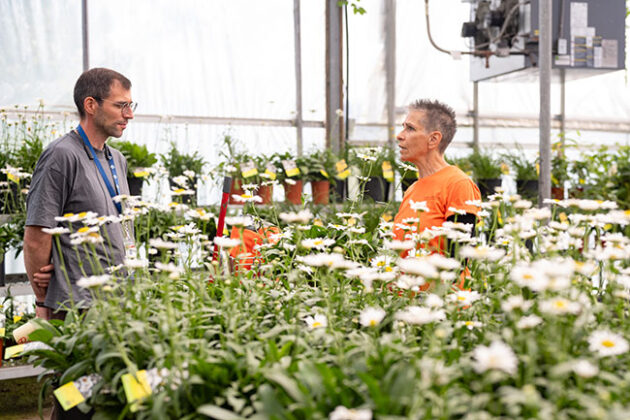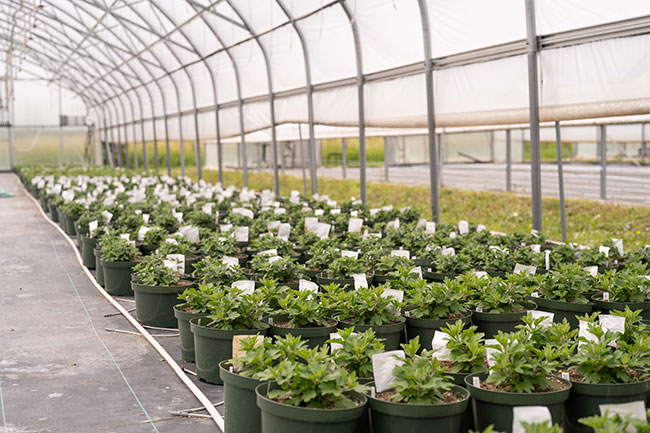Consumer trends: Canadian independent garden centres see growing interest in locally sourced plants and products
August 18, 2025
By Anne Kadwell and Stuart Service, Canadian Nursery Landscape Association
Across the country, independent garden centres are seeing a shift that reflects the political dynamics of North America. While many have always leaned into locally grown plants and Canadian-made goods, a growing number of customers are wanting to know the stories behind the products and where they came from.
The response has been both practical and principled, with operators adjusting buying habits, updating signage, and reconsidering what “local” really means.
“We’ve always sourced locally,” said Tanya Olsen of Royal City Nursery in Guelph, ON. “But now we’re getting asked about it.”
At her garden centre, most plants are grown within a one- to two-hour radius. For Olsen, the benefits are clear, as nearby suppliers provide plants that are stronger due to shorter travel distances, and are better adapted to the local climate.
Homegrown
“We have an incredible opportunity to be a lot louder about the fact that our plants are grown locally in Canada and for us in Guelph,” she said. “The wild part is: that’s always been the case.”
Tropicals and houseplants remain a challenge due to being mostly imported from the southern U.S. But recent customer aversions to purchasing American plant material has led Tanya to explore local options.
“There’s some fantastic Canadian growers that we may not have dealt with before, that have always been there, and that can fill some of those gaps,” she said.


Heather Saunders, Senior Product Adviser at Cedarcrest Gardens in St. John, NB, said her team took steps early in the season to spotlight their Canadian-grown offerings. Most annuals and perennials are grown at their own farm, while trees and shrubs come mainly from Ontario and Quebec.
Patriotic purchasing
The biggest difference this season for Saunders is a noticeable demand for Canadian flags.
“We could have sold hundreds,” she said. “It seemed like every second person coming in in the spring, when they were looking to replace their decorative flags, wanted a Canadian flag.”
Cedarcrest supports local food, crafts and giftware by hosting a farmers’ market in their greenhouse during the winter months.
“A lot of people like supporting the farmers market,” Saunders said. “And it gives the vendors something to do in the wintertime when they wouldn’t normally have anywhere to sell their goods.”
In Winnipeg, MB, Jordan Hiebert of Lacoste Garden Centre noted that many garden retailers have the rare ability to manufacture what they sell right on site.
“We manufacture the product we sell on location,” he said in an interview at his office.


“We grow our plants literally 100 feet beyond that wall right there,” Hiebert continued. “We can’t do that with clothing. It’s not like they’re sewing the clothes in the back and then bringing it up to the front for retail.”
Loving local
Early in the season, Hiebert noticed a wave of questions about where plants were coming from. His team responded with a campaign slogan: “locally grown, locally loved.” They’ve pivoted this year by ordering more hard goods from Canada, and visiting international suppliers in the Netherlands to further avoid relying on American sources.
“That sentiment was strong in the late winter, but relatively nonexistent in spring,” he said. “I don’t think I got asked the question a single time in May. Maybe we answered a lot of those questions so they didn’t get asked.”
In Stirling, ON, Karina Lapierre McIntosh of Lavish Gardens is also focused on local sourcing with an emphasis on how plants are propagated.
“I like to buy from local growers that grow from open pollinated seeds produced in our local environment,” she said. “I’m not a botanist, but I figured that the more diversity in the plant world is best because with climate change and the world that we live in, we want plants that have genetic diversity.”
The supply chain has its limits, as sourcing hard goods remains a challenge. “I did cancel some orders of hard goods that were from American suppliers. It was a little bit sad, but sometimes you just have to kind of do your part.”


Comments are closed.